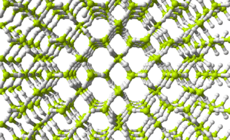Nonene
| Names | |
|---|---|
| IUPAC name
Non-1-ene | |
| Other names
alpha-Nonene | |
| Identifiers | |
3D model (JSmol) |
|
| ChEBI | |
| ChemSpider | |
| ECHA InfoCard | 100.004.257 |
| EC Number | 271-212-0 |
PubChem CID |
|
| |
| |
| Properties | |
| C9H18 | |
| Molar mass | 126.24 g/mol |
| Appearance | colorless liquid |
| Odor | onion-like, grassy |
| Density | 0.7433 g/cm3 |
| Melting point | −81.3 °C (−114.3 °F; 191.8 K) |
| Boiling point | 146.9 °C (296.4 °F; 420.0 K) |
| insoluble | |
| Solubility | soluble in alcohol |
| Hazards | |
| NFPA 704 | |
| Flash point | 26 °C (79 °F; 299 K) |
Except where otherwise noted, data are given for materials in their standard state (at 25 °C [77 °F], 100 kPa). | |
| Infobox references | |
Nonene is an alkene with the molecular formula C9H18. Many structural isomers are possible, depending on the location of the C=C double bond and the branching of the other parts of the molecule. Industrially, the most important nonenes are trimers of propene. This mixture of branched nonenes is used in the alkylation of phenol to produce nonylphenol, a precursor to detergents, which are also controversial pollutants.[1]
References
- ↑ Helmut Fiege, Heinz-Werner Voges, Toshikazu Hamamoto, Sumio Umemura, Tadao Iwata, Hisaya Miki, Yasuhiro Fujita, Hans-Josef Buysch, Dorothea Garbe, Wilfried Paulus "Phenol Derivatives" in Ullmann's Encyclopedia of Industrial Chemistry 2002, Wiley-VCH, Weinheim.doi:10.1002/14356007.a19_313.
This article is issued from
Wikipedia.
The text is licensed under Creative Commons - Attribution - Sharealike.
Additional terms may apply for the media files.







